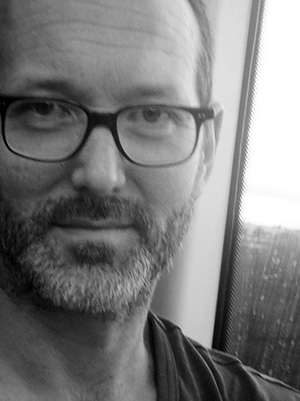
Julian Warner. Born 1967, in the Midlands. Married with a son. Lives in Finsbury Park, North London.
Abstract figures: the painting of Julian Warner

Julian Warner. Born 1967, in the Midlands. Married with a son. Lives in Finsbury Park, North London.
It is now a very long time since Kandinsky indicated that he would prefer the idea of the ‘concrete’ to that of the ‘abstract’ when thinking about non-figurative paintings. His argument is no weaker today than it was in the late 1930s, for it remains the concrete qualities of colour, form, facture and so on that are brought to the fore by ‘abstract’ painting. There is nothing ‘abstract’ about these qualities. They are real and affective without appeal to the intermediary of the figurative image, and it is through them that such painting communicates.
As Kandinsky also discovered, the figurative image itself is readily soluble: with minimal adjustments a clear representational image can be reconfigured as a wholly ‘abstract’ composition. Nevertheless, it is hard for painting to escape the inexorable pull of figuration, not least because a fundamental strength of representation is its ability to function with the most economical of means. The simplest dispositions of line are enough to trigger complex visual recognition, and this fact is complemented by the capacity of the visual sense to will the image into being out of raw material (a capacity that was recognised by Leonardo and the Surrealists among others). Form emerges readily from the formless; the abstract and the figurative have a much closer and more complex relationship than is usually admitted.
These uncertainties always attend abstract painting, and Julian Warner is not only attuned to them, but incorporates and works with them. The work is certainly ‘abstract’, in the conventional sense of the term – but Warner’s method of work does not deny the figurative, and often begins in it, using an image or fragment as a starting point for experiments with colour and investigations of form that escape figurative constraint.
In Warner’s studio, familiar images – newspaper cuttings, photographs, postcards, reproductions of well-known paintings – are analysed as visual open source material.
Torn into collages, simplified and transformed, once figurative images are re-articulated as free forms. Their colours are tested, changed and re-tested; their orientations are re-angled and realigned; they are brought into new relations with one another. Even here, at its moment of collapse, figuration is not necessarily eschewed – forms emerge from forms like mirages, and fresh visual suggestions prompt new directions as the character of the work develops.
Warner is not afraid to meet with the figure should it appear, for such an unsolicited arrival only adds a layer of depth, and provides a new stimulus to the evolution of the work. Forms coalesce as relationships between colour and shape are fine-tuned. Overpainting and reorganising, adjusting and altering, Warner allows the work to accrete, always trying to find the correct calibration, always looking for a steady state to establish itself.
A technique of this kind complicates the usual dichotomy between abstract and figurative. For Warner, the figurative is both loaded with non-figurative messages and also latent within the wholly abstract. It is not so much a case of trespassed borderlands between abstraction and figuration as one of a deep interconnection between the two that admits of no meaningful separation.
In the large works, craggy and indeterminate forms, complex in construction and facture, telescope together the very small and the very large. Softly glowing nebulae of colour unwind over the canvas like blooms of lichen, and rough agglomerations of paint push forward from dark, receding spaces as a bright and broken rubble. In the works on paper, strata of acrylic create deep chromatograms, mineral pools of colour with the dark luminescence of agates.
Warner’s painting does not necessarily seek these connections with the visible world. It is rather that the forms of abstract art are no more ‘abstract’ than the time-hewn forms of stones or the scattering of stars in the firmament, and its examination of line and colour no more alien to our sensibilities than the linear grain of wood or the brilliance of a bird’s plumage. Abstraction in this sense tends not away from the world, but towards it, and if resonances with the texture, hue and form of visible things are found within Warner’s painting it is not through mere coincidence. Their presence stems from an artistic sensibility and a painterly process that welcomes them in and encourages them to become concrete as the work moves, incrementally and meticulously, toward resolution.
Francis Gooding
March, 2011